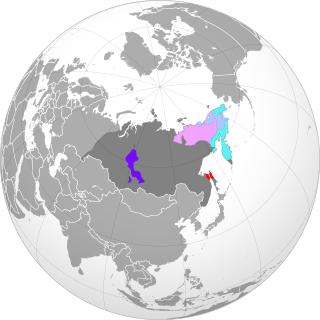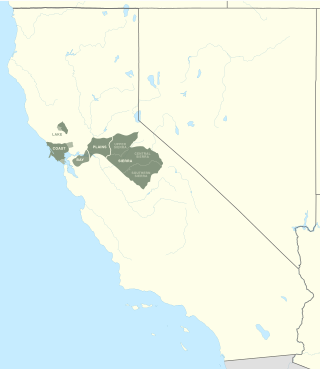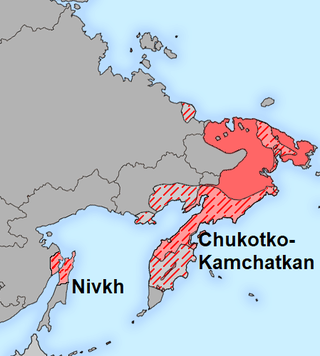
The Eskaleut, Eskimo–Aleut or Inuit–Yupik–Unangan languages are a language family native to the northern portions of the North American continent, and a small part of northeastern Asia. Languages in the family are indigenous to parts of what are now the United States (Alaska); Canada including Nunavut, Northwest Territories, northern Quebec (Nunavik), and northern Labrador (Nunatsiavut); Greenland; and the Russian Far East. The language family is also known as Eskaleutian, Eskaleutic or Inuit–Yupik–Unangan.
Nivkh, or Gilyak, or Amuric, is a small language family, often portrayed as a language isolate, of two or three mutually unintelligible languages spoken by the Nivkh people in Russian Manchuria, in the basin of the Amgun, along the lower reaches of the Amur itself, and on the northern half of Sakhalin. "Gilyak" is the Russian rendering of terms derived from the Tungusic "Gileke" and Manchu-Chinese "Gilemi" for culturally similar peoples of the Amur River region, and was applied principally to the Nivkh in Western literature.

The Paleo-Siberian languages are several language isolates and small language families spoken in parts of Siberia. They are not known to have any genetic relationship to each other; their only common link is that they are held to have antedated the more dominant languages, particularly Tungusic and latterly Turkic languages, that have largely displaced them. Even more recently, Turkic and especially Tungusic have been displaced in their turn by Russian.

The Chukotko-Kamchatkan or Chukchi–Kamchatkan languages are a language family of extreme northeastern Siberia. Its speakers traditionally were indigenous hunter-gatherers and reindeer-herders. Chukotko-Kamchatkan is endangered. The Kamchatkan branch is moribund, represented only by Western Itelmen, with only 4 or 5 elderly speakers left. The Chukotkan branch had close to 7,000 speakers left, with a reported total ethnic population of 25,000.

Koryak is a Chukotko-Kamchatkan language spoken by 1,665 people as of 2010 in the easternmost extremity of Siberia, mainly in Koryak Okrug. It is mostly spoken by Koryaks. Its close relative, the Chukchi language, is spoken by about three times that number. The language together with Chukchi, Alutor and Itelmen forms the Chukotko-Kamchatkan language family. Its native name in Koryak is нымылан nymylan, but variants of the Russian "Koryak" name are most commonly used in English and other languages.

Uralo-Siberian is a hypothetical language family consisting of Uralic, Yukaghir, and Eskaleut. It was proposed in 1998 by Michael Fortescue, an expert in Eskaleut and Chukotko-Kamchatkan, in his book Language Relations across Bering Strait. Some have attempted to include Nivkh in Uralo-Siberian. Until 2011, it also included Chukotko-Kamchatkan. However, after 2011 Fortescue only included Uralic, Yukaghir and Eskaleut in the theory, although he argued that Uralo-Siberian languages have influenced Chukotko-Kamchatkan.

Itelmen or Western Itelmen, formerly known as Western Kamchadal, is a language of the Chukotko-Kamchatkan family spoken on the western coast of the Kamchatka Peninsula. Fewer than a hundred native speakers, mostly elderly, in a few settlements in the southwest of Koryak Autonomous Okrug, remained in 1993. The 2021 Census counted 2,596 ethnic Itelmens, virtually all of whom are now monolingual in Russian. However, there are attempts to revive the language, and it is being taught in a number of schools in the region.

Kerek is an extinct language in Russia of the northern branch of the Chukotko-Kamchatkan languages. On historical linguistic grounds it is most closely related to Koryak. The next closest relative is Chukchi.

The Miwok or Miwokan languages, also known as Moquelumnan or Miwuk, are a group of endangered languages spoken in central California by the Miwok peoples, ranging from the Bay Area to the Sierra Nevada. There are seven Miwok languages, four of which have distinct regional dialects. There are a few dozen speakers of the three Sierra Miwok languages, and in 1994 there were two speakers of Lake Miwok. The best attested language is Southern Sierra Miwok, from which the name Yosemite originates. The name Miwok comes from the Northern Sierra Miwok word miw·yk meaning 'people.'
Mosan is a hypothetical language family consisting of the Salishan, Wakashan, and Chimakuan languages of the Pacific Northwest region of North America. It was proposed by Edward Sapir in 1929 in the Encyclopædia Britannica. Little evidence has been adduced in favor of such a grouping, no progress has been made in reconstructing it, and it is now thought to reflect a language area rather than a genetic relationship. The term persists outside academic linguistic literature because of Sapir's stature.

Chukotkan is a dialect cluster that forms one branch of the Chukotko-Kamchatkan language family. It is spoken in two autonomous regions at the extreme northeast of Russia, bounded on the east by the Pacific and on the north by the Arctic.
Michael David Fortescue is a British-born linguist specializing in Arctic and native North American languages, including Kalaallisut, Inuktun, Chukchi and Nitinaht.
Proto-Chukotko-Kamchatkan is the reconstructed common ancestor of the Chukotko-Kamchatkan languages. It is purported to have broken up into the Northern (Chukotian) and Southern (Itelmen) branches around 2000 BCE, when western reindeer herders moved into the Chukotko-Kamchatkans' homeland and its inland people adopted the new lifestyle.
Edward J. Vajda is a historical linguist at Western Washington University, Washington.
Haruai is one of two languages of the Piawi family of New Guinea. The language has borrowings from Kalam. Young men are likely to know Kobon and Tok Pisin, but many Haruai are monolingual. Haruai is also commonly known as Waibuk, also Wiyaw, Wovan, Taman.

The Eskimo–Uralic hypothesis posits that the Uralic and Eskimo–Aleut language families belong to a common macrofamily. It is not generally accepted by linguists because the similarities can also be merely areal features, common to unrelated language families. In 1818, the Danish linguist Rasmus Rask grouped together the languages of Greenlandic and Finnish. The Eskimo–Uralic hypothesis was put forward by Knut Bergsland in 1959. Ante Aikio stated that it's possible that there exists some connection between the two families, but exact conclusions can't be drawn and the similarities could exist by loaning.

Northern Pashto is a standard variety of the Pashto language spoken in Khyber Pakhtunkhwa, Pakistan, comprising the Northwestern and Northeastern dialects of Pashto.

The Ainu languages, sometimes known as Ainuic, are a small language family, often regarded as a language isolate, historically spoken by the Ainu people of northern Japan and neighboring islands.

The Chukotko-Kamchatko-Amuric or Chukotko-Kamchatkan-Amuric languages form a hypothetical language family including Nivkh and Chukotko-Kamchatkan. A relationship between these two language groups was proposed by Michael Fortescue in a 2011 paper. He theorized that their common ancestor might have been spoken around 4000 years ago. However Glottolog says that the evidence is insufficient to conclude a genealogical relationship between Nivkh and Chukotko-Kamchatkan.
This article discusses the phonology of the Chukchi language. The Chukchi language, also known as Chukot or Luorawetlan, is a language spoken by around 5 thousand people in Chukotka Autonomous Okrug. The endonym of the Chukchi language is Ԓыгъоравэтԓьэн йиԓыйиԓ , pronounced as [ɬəɣˀorawetɬˀɛn jiɬəjiɬ]. Chukchi is in the Chukotko-Kamchatkan family, and thus is closely related to Koryak, Kerek, Alyutor, and more distantly related to Itelmen, Southern Kamchadal, and Eastern Kamchadal.











